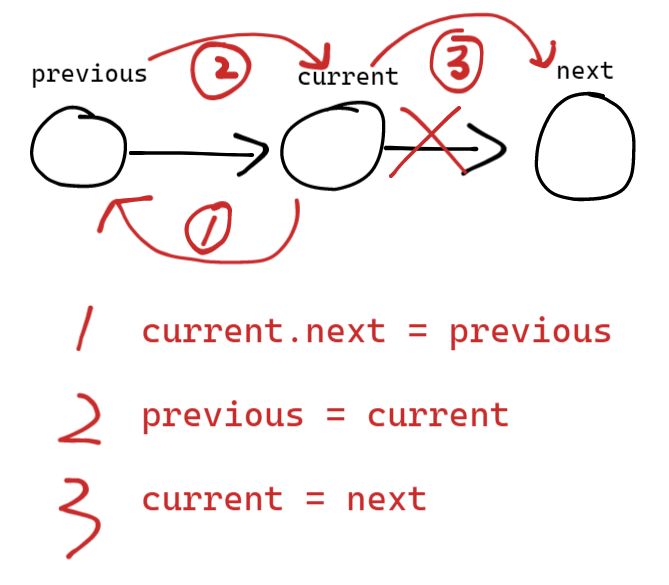Leetcode 203.移除链表元素
题目:203. 移除链表元素
初始思路
代码
var removeElements = function (head, val) {// 添加一个虚拟头结点 不用考虑删除第一个节点的情况const dummyHead = new ListNode(0)// 虚拟头结点链接着原来的head节点dummyHead.next = head// temp是遍历用的指针let temp = dummyHeadwhile (temp.next !== null) {if (temp.next.val == val) {// 如果等于这个值就往后链接节点temp.next = temp.next.next} else {// 如果不等于就继续遍历temp = temp.next}}// 返回虚拟头结点的下一个节点,就是题目需要的新链表的头结点return dummyHead.next};
感想
- 删除节点的操作很简单,就是把next节点链接到next.next节点上。
- 重点是考察虚拟头结点的使用,如果不使用虚拟头结点的话,需要考虑删除的是不是头结点。使用了虚拟头结点之后,把所有节点都看成一样性质的节点,减少了判断。
Leetcode 707.设计链表
题目:707. 设计链表 coderwhy的JavaScript数据结构与算法:https://www.bilibili.com/video/BV1x7411L7Q7 讲解:https://www.bilibili.com/video/BV1FU4y1X7WD
初始思路
之前看coderwhy老师的课的时候手写了一遍单向链表和双向链表,有熟悉的感觉,但是写起来还是很复杂很痛苦!下标很麻烦,而且有一些越界判断。
代码
class Node {constructor(val, next) {this.val = valthis.next = next}}var MyLinkedList = function () {this.head = nullthis.tail = nullthis.length = 0};/*** @param {number} index* @return {number}* 获取链表中第 index 个节点的值。如果索引无效,则返回-1。*/MyLinkedList.prototype.get = function (index) {if (index < 0 || index >= this.length) return -1let current = this.headlet temp = 0while (temp++ < index) {current = current.next}return current.val};/*** @param {number} val* @return {void}* 在链表的第一个元素之前添加一个值为 val 的节点。插入后,新节点将成为链表的第一个节点。*/MyLinkedList.prototype.addAtHead = function (val) {let newNode = new Node(val, this.head)this.head = newNodethis.length++if (!this.tail) {// 如果尾结点是空,指向新节点this.tail = newNode}};/*** @param {number} val* @return {void}* 将值为 val 的节点追加到链表的最后一个元素。*/MyLinkedList.prototype.addAtTail = function (val) {let newNode = new Node(val, null)this.length++if (this.tail) {this.tail.next = newNodethis.tail = newNodereturn}this.tail = newNodethis.head = newNode};/*** @param {number} index* @param {number} val* @return {void}* 在链表中的第 index 个节点之前添加值为 val 的节点。如果 index 等于链表的长度,则该节点将附加到链表的末尾。如果 index 大于链表长度,则不会插入节点。如果index小于0,则在头部插入节点。*/MyLinkedList.prototype.addAtIndex = function (index, val) {if (index > this.length) returnif (index <= 0) {this.addAtHead(val)return}if (index == this.length) {this.addAtTail(val)return}let temp = 0 // 遍历索引初始化为0let current = this.head // 遍历的当前节点初始化为headlet previous = null // 遍历的上一节点初始化为nulllet newNode = new Node(val, null)while (temp++ < index) {previous = currentcurrent = current.next}// 在当前节点和当前节点的上一节点之间插入新节点,即改变它们的指向newNode.next = currentprevious.next = newNodethis.length++};/*** @param {number} index* @return {void}* 如果索引 index 有效,则删除链表中的第 index 个节点。*/MyLinkedList.prototype.deleteAtIndex = function (index) {// 越界判断if (index < 0 || index >= this.length) returnif (index == 0) {// 删除头结点this.head = this.head.next// 如果删除的这个节点同时是尾结点,也需要处理if (index === this.length - 1) {this.tail = this.head}} else {let temp = 0let current = this.headlet previous = nullwhile (temp++ < index) {previous = currentcurrent = current.next}// 处理尾结点if (index === this.length - 1) {this.tail = previous} else {// 让上一节点的 next 指向当前的节点的 next,相当于删除了当前节点。previous.next = current.next}}this.length--};
感想
- 写起来真的很痛苦,只能说熟能生巧吧。
- 写法和代码随想录提供的思路不一样,是按照coderwhy老师的思路写的。
- coderwhy老师的课真的讲的不错,可惜没时间看,之后有空把课程补完。
Leetcode 206.反转链表
题目:206. 反转链表
初始思路
暴力解法就是新建一个链表存储反转后的链表,但是浪费空间,之前在原地修改链表即可。
代码
var reverseList = function (head) {let current = headlet previous = null// 从前往后遍历while (current) {// 提前存储next节点let next = current.next// 让每个节点的next指向前一个节点current.next = previous// 更新previous位置previous = current// 更新current位置current = next}return previous};
感想
- 没有上一道题复杂。
- 还是要掌握原地反转链表的方法,指向弯弯绕绕的有点难写写
- 图示


